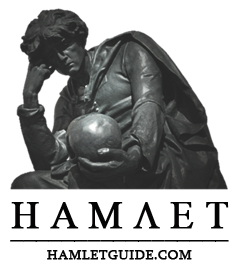

![]()
| Hamlet, by Boris Pasternak, from I Remember. |
|
The characters are sharply differentiated by the rhythm of their speech. Polonius, the King, Guildenstern and Rosencrantz speak in one way, Laertes, Ophelia, Horatio, and the rest in another. The credulity of the Queen is shown not only in her words but also by her singsong manner of drawing out her vowels. So vivid is the rhythmic characterization of Hamlet himself that it creates the illusion of a leitmotif, as though a musical phrase were reiterated at his every appearance on the stage, although in fact no such leitmotif exists. The very pulse of his being seems to be made audible. Everything is contained in it: his inconsistent gestures, his long, resolute stride and the proud half-turn of his head, as well as the way in which the thoughts he utters in his monologues leap and take flight, the mocking arrogance of his ripostes to the courtiers who mill round him, and his manner of staring into the distance of the unknown whence his father’s ghost once summoned him and where it may at any moment speak again. Neither the music of Hamlet’s speech nor that of the play as a whole lends itself to quotation: it is impossible to give an impression of it by any one example. Yet, disembodied though it is, so ominously and so closely is it woven into the texture of the tragedy that, given the subject, one is tempted to describe it as Scandinavian and as suited to the climate of apparitions. It consists in a measured alternation of solemnity and disquiet and, by thickening the atmosphere to its utmost density, it brings out the dominant mood. What is this mood? According to the well-established view of critics, Hamlet is a tragedy of the will. This is true. But in what sense is it to be understood? Absence of will power did not exist as a theme in Shakespeare’s time: it aroused no interest. Nor does Shakespeare’s portrait of Hamlet, drawn so clearly and in so much detail, suggest a neurotic. Hamlet is a prince of the blood who never, for a moment, ceases to be conscious of his rights as heir to the throne; he is the spoilt darling of an ancient court, and self-assured in the awareness of his natural gifts. The sum of qualities with which he is endowed by Shakespeare leaves no room for flabbiness: it precludes it. Rather, the opposite is true: the audience, impressed by his brilliant prospects, is left to judge of the greatness of his sacrifice in giving them up for a higher aim. From the moment of the ghost’s appearance, Hamlet gives up his will in order to "do the will of him that sent him." Hamlet is not a drama of weakness, but of duty and self-denial. It is immaterial that, when appearance and reality are shown to be at variance— to be indeed separated by an abyss—the message is conveyed by supernatural means and that the ghost commands Hamlet to exact vengeance. What is important is that chance has allotted Hamlet the role of judge of his own time and servant of the future. Hamlet is the drama of a high destiny, of a life devoted and preordained to a heroic task. This is the overall tone of the play, so concentrated by the rhythm as to be almost palpable. But the rhythmic principle is applied in still another way. It has a softening effect on certain harsh scenes which would be intolerable without it. Thus for instance, in the scene in which he sends Ophelia to a nunnery, Hamlet speaks to the girl who loves him, and whom he tramples underfoot, with the ruthlessness of a self-centered Byronic rebel. His irony is out of keeping with his own love for her, which he painfully suppresses in himself. But let us see how this heartless scene is introduced. Immediately before it comes the famous speech, "To be or not to be," and the fresh music of the monologue still echoes in the opening verses which Hamlet and Ophelia exchange. The bitter and disorderly beauty of the monologue in which Hamlet’s perplexities crowd and overtake each other and remain unsolved recalls the sudden chords, abruptly cut off, tried out on the organ before the opening of a requiem. No wonder that the monologue heralds the beginning of the cruel denouement. It precedes it as the funeral service precedes the burial. The way is opened by it for whatever is inevitable, and whatever follows is washed, redeemed, and lent majesty in advance not only by the spoken thoughts but by the ardor and purity of he tears which ring in it. Hamlet Translated by Andrey Kneller The clamor ceased. I walked onto
the stage. 1946 |
![]()